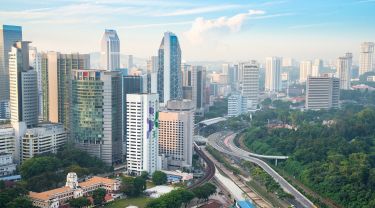Malaysia is a rapidly expanding economy in the Indo-Pacific region, with a growth trajectory that transformed it from a largely agricultural, low-income economy to a modern country with a diversity of thriving industries. In its vibrant landscape, cutting-edge architecture lives alongside lush rainforests and pristine beaches.
According to the World Bank Group, this relatively young nation—recognized as a country in 1963—is on track to transition from its current upper-middle income status into a high-income economy between 2028 to 2030.
Canadian exporters should take note, says Xiang Liang Chan, Export Development Canada’s (EDC) chief representative in South Asia.
“Malaysia is a market of strategic importance for Canadian exporters and boasts well-developed infrastructure, a strong financial sector and a business-friendly regulatory environment, making it an attractive destination for trade and investment,” she says. “Now really is the time to look at Malaysia as an export destination.”

Malaysia and Canada share strong trade ties, with bilateral trade reaching $5.2 billion in 2024. Canadian exports range from fertilizers, aluminium and cereals to oilseeds and electrical machinery. Canada’s involvement in the Comprehensive and Progressive Agreement for Trans-Pacific Partnership (CPTPP) gives Canadian companies interested in doing business in Malaysia preferential access to the market by reducing tariffs and trade barriers.
“Trade agreements such as CPTPP provide Canadian businesses with a competitive edge,” says Nathan Nelson, EDC’s regional vice-president for South and Southeast Asia. “These agreements help streamline regulatory processes and enhance market access.”
A key factor driving export opportunities for Canadian businesses is Malaysia’s solid commitment to decarbonizing, modernizing and transforming into a digital economy— ambitions that are boosting investments and economic activity across many sectors.
In 2024, Malaysia’s gross domestic product (GDP) hit an estimated US$430 billion and is expected to grow at a rate of 4.5% annually over the next five years. Today, it’s one of the largest economies in the Association of Southeast Asian Nations (ASEAN).
“Malaysia’s economic strength is rooted in its commitment to modernization, digital transformation and sustainability initiatives,” says Nadeem Rizwan, an economist and country risk analyst at EDC, focused on South and Southeast Asia. “With its stable economic policies and proactive government support, Malaysia has become one of the preferred destinations for exporters, as well as for multinational corporations looking to establish regional headquarters in Southeast Asia.”
The country’s population also continues to expand. Its average growth rate of 1.2% over the last five years is relatively high, compared to other countries in the region, says Rizwan. As of 2024, Malaysia’s population topped 35.6 million, of which about 70% are of working age. Seniors represent just under 8% of the population, while children account for just above 20%.
A notable feature of Malaysia’s population is its strong and growing middle class, whose higher purchasing power has been driving demand for high-value goods and services, says Rizwan. Malaysians are also increasingly educated, notes the World Bank. In 2021, 33% of the country’s workforce had post-secondary education—a 10% increase from 2010. At the same time, the average pre-tax income of Malaysians has grown at an average rate of 7.3% annually between 1961 and 2023, according to the World Bank.
Malaysia is ahead of its peer countries when it comes to global trade. According to the World Bank, Malaysia trades with almost 90% of the world’s countries and is highly integrated into global supply chains. For Canadian companies keen on doing business in Malaysia, the market offers great potential in many sectors:
- Agri-food. Malaysia is highly dependent on imported food, with nearly 70% of its food supply coming from abroad. Canada’s agri-food sector enjoys a strong reputation in this country, particularly in commodities such as wheat, soybeans and potash fertilizers. In 2023, Malaysia imported close to $270 million of agri-food and seafood from Canada, according to Canada’s Trade Commissioner Service (TCS).
The Malaysian consumer market is also shifting towards healthier, organic and sustainable food products—a trend that aligns well with Canada’s strong reputation for high-quality agri-food exports, says Chan. - Halal foods. Increasing consumer demand for halal-certified food presents a niche opportunity for Canadian exporters of raw and semi-processed ingredients such as wheat, soybeans, canola oil, dried fruits and food additives. The Department of Islamic Development Malaysia currently recognizes three halal certification agencies in Canada: Halal Montreal Certification Authority, Halal Monitoring Authority Canada and Islamic Food and Nutrition Council of America. Obtaining Malaysia-recognized halal certification gives Canadian food exporters access to the Malaysian market, as well as to broader markets across the Muslim-majority regions of Asia and the Middle East.
- Clean technology and renewable energy. Malaysia has set ambitious targets to achieve net zero emissions by 2050. The government is investing heavily in renewable energy, including solar, wind and hydrogen projects. Canada, recognized as a global leader in clean technology, is well-positioned to provide innovative solutions in energy efficiency, green hydrogen and sustainable manufacturing.
“Canadian expertise in hydroelectric power, carbon capture and hydrogen technologies aligns well with Malaysia’s green energy transition goals, which are set out in the country’s National Energy Transition Roadmap,” says Chan.
The country’s growing data centre industry also presents opportunities for clean energy solutions. Canadian firms specializing in energy-efficient cooling systems and smart grid technologies may find an emerging market in this sector. - Information and communication technology (ICT). Malaysia is positioning itself as a digital hub in Southeast Asia and has made major investments in artificial intelligence (AI), cybersecurity, cloud computing and e-commerce. The Malaysian Digital Economy Blueprint outlines plans to increase digital adoption across industries, with a focus on smart cities, fintech and automation. Canadian firms specializing in cybersecurity, data analytics and AI-driven business solutions can benefit from these efforts.
Malaysia’s increasing internet penetration and tech-savvy consumer base are also fuelling demand for digital payment systems, blockchain solutions and software-as-a-service (SaaS) products. - Infrastructure and smart cities. Malaysia’s infrastructure sector is undergoing rapid expansion, with major projects in transportation, smart cities and urban development. The government’s ambitious plans—detailed in its Twelfth Malaysia Plan (2021–2025) and 13th Malaysia Plan (2026-2030)—focus on major infrastructure investments, including roads, railways, airports and renewable energy projects.
Canadian firms specializing in engineering, smart infrastructure and urban mobility solutions have opportunities to support Malaysia’s modernization initiatives. Smart city projects such as the Iskandar Malaysia development are integrating the Internet of Things (IoT), AI and green building technologies—areas where Canadian firms have a competitive advantage. Malaysia’s investments in transportation infrastructure, such as high-speed rail and metro expansions, also provide opportunities for Canadian companies with expertise in smart transit systems and digital infrastructure. - Aerospace and advanced manufacturing. Rizwan notes that Malaysia has outlined a strategic vision to become a regional aerospace hub, focusing on maintenance, repair and overhaul services. The country’s established aerospace industry, supported by investments in manufacturing, logistics and research, creates opportunities for Canadian firms specializing in aircraft components, avionics and engineering solutions.
“Malaysia’s aerospace industry blueprint includes initiatives with the goal of positioning Malaysia as Southeast Asia’s most significant aerospace hub,” says Rizwan. “This represents opportunities for anything related to aerospace manufacturing, and Canada is well-known for our expertise in aerospace.”
Malaysia’s push for automation and digitalization in manufacturing also aligns with Canada’s strengths in industrial robotics, advanced materials and precision engineering, he says.
While Malaysia offers significant opportunities, Canadian exporters should be aware of certain challenges in the market.
- Competition: Malaysia is a competitive market where product differentiation and value proposition are key for Canadian exporters. “There’s competition from regional players with comparable products and of closer proximity. Canadian exporters can differentiate themselves by highlighting quality, innovation and reliability in their offerings,” says Chan.
- Distance: The time difference and distance between Canada and Malaysia can make it challenging to connect with buyers and partners in the market. There’s also no direct logistical connection between Canada and Malaysia, which can lead to higher exporting costs for Canadian companies.
- Regulations: Canadian exporters must navigate Malaysia’s import regulations, including customs procedures and product labelling and certifications. Companies seeking to enter the market could consider forming local partnerships to reduce market entry barriers and navigate local laws and customs, says Chan.
- Culture: Canadian companies must be mindful of Malaysia’s multicultural society, which is predominantly Muslim, notes Chan. It’s also important to understand local business culture, which often favours conservative attire and social interactions ahead of business discussions.
For help with overcoming trade barriers and navigating regulations, Canadian companies should consider the Labuan International Business and Financial Centre, a special economic zone on the island of Labuan set up by the Malaysian government.
Chan says Canadian businesses looking to enter the market can also tap into the resources and network of the Malaysian Investment Development Authority (MIDA), a government agency that supports foreign businesses looking to enter the market.
MIDA works with Malaysia’s five regional economic development authorities, each responsible for an economic corridor focused on specific industries. For example, the Northern Corridor Implementation Authority (NCIA), which covers the northern states of Perlis, Kedah, Pulau Pinang and Perak, prioritizes manufacturing, agri-business, tourism and logistics. By comparison, the Sarawak Corridor of Renewable Energy (SCORE) on the Malay Archipelago is focused on building a green energy economy.
“Understanding economic corridors and the associated cluster ecosystem, supply chain synergies and infrastructure is crucial” Chan explains.
As part of our Indo-Pacific strategy, EDC is committed to helping Canadian companies diversify into new markets and succeed in this dynamic region.
Discover how EDC’s financial and knowledge solutions can help you understand the opportunities in your target market and make exporting less risky. Visit EDC’s Export Help Hub or subscribe to EDC’s TradeInsights newsletter for the latest updates.
By understanding the opportunities and challenges in Malaysia, Canadian businesses can make informed decisions about entering this promising market. With the right strategy, strong partnerships and support from organizations like EDC, Canada’s exporters can successfully tap into one of Southeast Asia’s most dynamic economies.
Connect with EDC and watch your business flourish on the international stage.
Answer a few questions about your company to learn more about how EDC can help you plan, connect and fuel your expansion in the Indo-Pacific.



